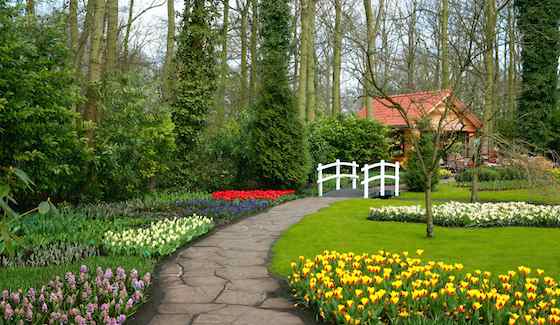By Sean Conway

On a blazing October day, gardening may be the last thing on your mind. While I am usually tempted to sit back on the patio and soak up the year's last warm sun, I know that days like these are the best time to work in the garden before the weather turns. There is nothing I hate more than doing fall chores in cold, wet weather.
The spring blooming bulbs I ordered have arrived in the mail, and planting them on a nice day makes the job a lot more pleasurable. I prepare for planting them ahead of time by cleaning up my beds, cutting back perennials that are looking rangy, which allows them time to form neat mounds of basal foliage before winter sets in. Cutting back perennials in the fall makes them look a lot more attractive and makes spring garden prep a breeze. I also systematically remove any annuals that have stopped blooming. Moisture in the ground makes pulling them out, roots and all, a lot easier.
Once the beds are cleaned up, I assess where I want to plant spring blooming bulbs. As a rule of thumb, try to remember to plant in large numbers instead of just clumps of one to five. I try to plant bulbs so they look like they have "naturalized" -- which is to say, I plant them in large random groupings that are irregular in shape but near each other, much as colonies of blooming plants are clustered in a field or woodland.
I also begin digging up summer blooming bulbs such as cannas, callas and dahlias just before the first frost. A day or two before an imminent frost, I cut back my dahlias. A hard frost turns many plants black and mushy, and I find that cutting them back beforehand makes the task much easier. I also harvest the last of the dahlia flowers, dispensing bunches to friends and neighbors.
After I cut the tops of the plants back to about 8 inches above the soil, I carefully dig the bulbs. Instead of shaking the soil from the roots, I leave it clinging to the long banana-like tubers. I then place the clumps, dirt and tubers alike, into plastic milk crates lined with plastic garbage bags. I fill the lined crates 1/3 full with coarse vermiculite, and place the clumps on top of it.
I let the clumps sit in the crates, uncovered, for a few days in the open air (move them inside if rain is expected) before covering the clumps completely with vermiculite. I make sure there is a minimum of 6 inches of vermiculite over the top of the clumps. The vermiculite will allow the tubers to breathe but will also help hold in moisture so they don't dry out during their winter dormancy.
I store the crates in the basement, stacked one on top of the other. I keep my basement at about 45 to 50 degrees, but as long as the tubers are kept above freezing and lower than 60, they will be fine until it is time to plant them back out next spring. If anything, err on the cool side. Warm temperatures can dry tubers out.
Taking care of chores like digging and planting bulbs is a lot easier while the weather is still nice. It means I can look out the window on those cold rainy days that lie ahead without feeling the slightest but of guilt.
Copyright ©, TRIBUNE MEDIA SERVICES, INC
AUTOS | HOBBIES | EDUCATION | FAMILY | FASHION | FOOD & RECIPES | HOME DECOR | RELATIONSHIPS | PARENTING | PETS | TRAVEL | WOMEN
Home & Garden - Out With the Summer Bulbs and in With the Spring